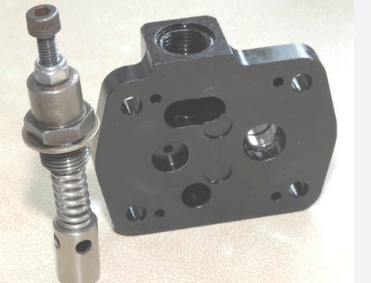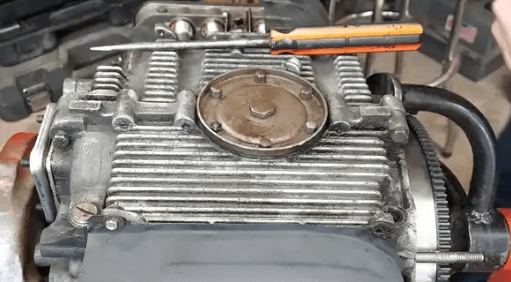To unstick the oil pressure relief valve, turn it counterclockwise to loosen it. Apply a small amount of penetrating oil directly onto the valve, wait a few minutes, and use a wrench to turn the valve back and forth to help loosen it further.
Be careful not to damage the valve or its components. A stuck oil pressure relief valve can cause high oil pressure and potentially damage the engine.
Step 1: Locating The Valve
Step 1: Study The Manual To Identify The Location Of The Pressure Relief Valve
Before attempting to unstick the oil pressure relief valve, it’s crucial to study the engine manual to familiarize yourself with the valve’s location. This will ensure that you can easily locate the valve and proceed with the necessary steps. In most engines, the pressure relief valve is typically black-colored and can be found in the engine.
Refer to the manual’s diagrams and descriptions to accurately identify the position of the valve within the engine. This will save you time and prevent any inadvertent damage to other components while attempting to unstick the valve.
Step 2: Gather The Necessary Tools
Once you have located the oil pressure relief valve, it’s time to gather the necessary tools to carry out the unstick process. The tools you will need include:
- A screwdriver: To unscrew the valve counterclockwise and loosen it.
- A blow gun: To apply a small amount of air pressure to the valve without damaging it or its components.
- Penetrating oil: To help lubricate and loosen the valve.
Having these tools ready will ensure a smooth and efficient process of unstick the oil pressure relief valve.
Step 3: Loosen The Stuck Valve
Now that you have the necessary tools and knowledge of the valve’s location, it’s time to proceed with unstick it. Follow these step-by-step instructions:
- Spray the penetrating oil directly on the valve and allow it to sit for a couple of minutes. This will help lubricate and loosen the stuck valve.
- Using a wrench, gently turn the valve back and forth to loosen it up. Be cautious not to apply excessive force to avoid causing damage to the valve or its components.
- If the valve remains stuck after the previous steps, use a blow gun to apply a small amount of air pressure to the valve. This gentle and controlled pressure can help free the valve.
Continue with these steps until the oil pressure relief valve is successfully unstuck. Remember to always exercise caution and follow proper safety measures while working on your engine.

Credit: rennlist.com
Step 2: Applying Penetrating Oil
Spray Penetrating Oil Directly Onto The Valve.
Once you have located the oil pressure relief valve, it’s time to apply some penetrating oil. This step is crucial in loosening any debris or buildup that may be causing the valve to stick. To do this, simply take your can of penetrating oil and spray it directly onto the valve.
Allow The Oil To Sit For A Couple Of Minutes To Loosen Any Debris Or Buildup.
After applying the penetrating oil, it’s important to allow it some time to work its magic. Give the oil a couple of minutes to penetrate the valve and loosen any debris or buildup that may be causing it to stick. This will make it easier to manipulate and free up the valve.
Once you’ve let the oil sit for a couple of minutes, you can proceed to the next step, which involves using a wrench to turn the valve back and forth to help loosen it up even further.
Step 3: Loosening The Valve
Now that you have located the oil pressure relief valve, it’s time to start loosening it up. This step is crucial in ensuring that the valve regains its functionality and allows oil to flow freely through the engine. Follow these instructions to successfully loosen the valve:
- Start by spraying a penetrating oil directly on the valve. Allow the oil to sit for a couple of minutes, as it will help to dissolve any grime or debris that may be causing the valve to stick.
- Once the penetrating oil has had enough time to work its magic, grab a wrench and position it onto the valve. The wrench will provide you with the necessary leverage to turn the valve back and forth.
- Using gentle, yet firm, pressure, start turning the valve counterclockwise and then clockwise. This back-and-forth motion helps to loosen the valve, breaking apart any remaining buildup or obstructions that may be preventing it from functioning properly.
- Continue turning the valve back and forth until you feel it becoming easier to move. This is a sign that the valve is gradually loosening.
Remember to be patient and avoid using excessive force when loosening the valve. Applying too much pressure could potentially damage the valve or its components.
Step 4: Using Air Pressure
Using a blow gun, apply a small amount of air pressure to the valve. This step is crucial in unsticking the oil pressure relief valve and ensuring that it functions properly again.
When applying air pressure, it is important to exercise caution to avoid damaging the valve or its components. Here’s how you can do it:
- First, ensure that the blow gun is set to a low pressure setting to prevent excessive force.
- Position the blow gun nozzle near the valve, making sure it is properly aligned.
- Gently squeeze the trigger to release a small amount of air pressure.
- Continue applying air pressure while keeping an eye on the valve.
- Observe any changes in the valve’s movement or responsiveness.
By using this method, you can effectively dislodge any debris or buildup that may be causing the oil pressure relief valve to stick. However, it is crucial to avoid applying excessive air pressure, as it could potentially damage the valve or its internal components.

Step 5: Reassembling The Valve
Once you have successfully cleaned and inspected the oil pressure relief valve, it’s time to reassemble all the removed components. Follow the reverse order of their removal to ensure everything is put back in its correct place.
Make sure to adhere to the following steps:
- First, start by positioning the valve body in its proper place.
- Next, carefully insert the relief valve and ensure it fits snugly.
- Proceed to secure the valve assembly by tightening the valve body using a wrench. Ensure everything is tightened securely.
- After that, reconnect the oil pressure relief valve spring and ensure it is properly seated in place.
- Lastly, reattach any other components or connections such as gaskets, O-rings, or bolts that were removed during the disassembly process. Make sure to follow the reverse order of their removal.
By following these steps, you can confidently reassemble the oil pressure relief valve and restore it to its proper functioning state.
Frequently Asked Questions On How To Unstick Oil Pressure Relief Valve
What Would Happen If The Oil Pressure Relief Valve Is Stuck Open?
If the oil pressure relief valve is stuck open, it can cause excessive oil to bleed off, resulting in a lack of oil pressure. This can lead to catastrophic engine damage and damage to the oil filter. It is important to address this issue promptly to avoid further complications.
What Are Symptoms Of Bad Oil Pressure Relief Valve?
Symptoms of a bad oil pressure relief valve include high oil pressure, lack of oil pressure, engine damage, and a stuck valve. If the valve is stuck open, there may be excessive oil bleeding off, resulting in low oil pressure and potential engine damage.
If the valve is stuck closed, it can cause overpressure and damage to the valve and system. Avoid forcing a valve closed as it can cause further damage.
Why Won’t My Pressure Relief Valve Close?
If your pressure relief valve won’t close, it may be due to overpressure or valve damage. Forcing the valve closed can cause further damage. To unstick the valve, try turning it counterclockwise or apply a small amount of air pressure.
If the issue persists, it is recommended to consult a professional for assistance to avoid catastrophic engine damage.
Can A Stuck Valve Cause Low Oil Pressure?
A stuck valve can cause low oil pressure as it prevents proper oil flow through the engine. If the relief valve is stuck in the open position, oil will be dumped back to the sump instead of circulating through the engine, resulting in little or no oil pressure.
Conclusion
If you are facing issues with a stuck oil pressure relief valve, there are a few simple steps you can take to unstick it. Locate the valve and turn it counterclockwise to loosen it. Applying a small amount of air pressure with a blow gun can also help.
Additionally, using penetrating oil and carefully using a wrench to turn the valve back and forth can help loosen it up. Remember to always refer to the manual for proper instructions.


Leave a Reply